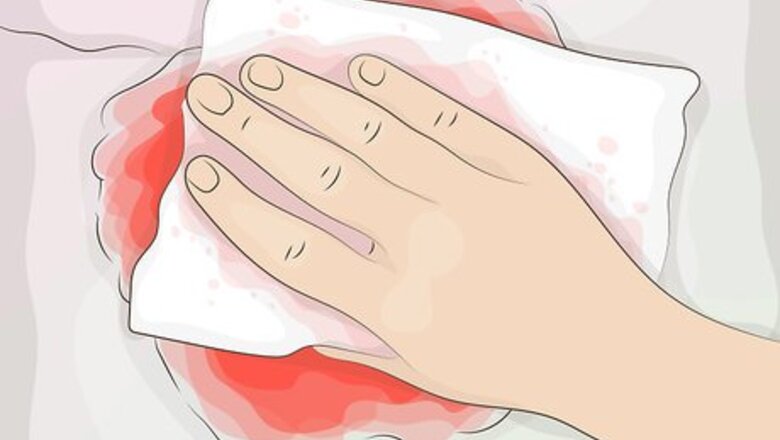
views
Cleaning Wet Stains
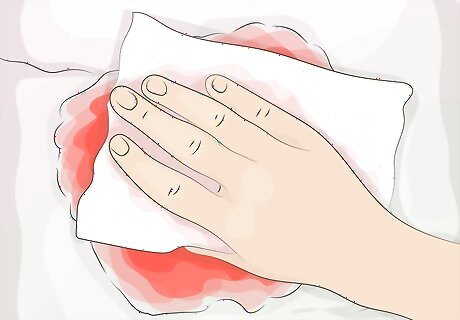
Blot up the excess wet paint. If you've caught the stain at an early point, you're in luck. Paint stains become much harder to clean if they're allowed to dry. Water-based paints like spray paint may be reduced considerable by putting it in the sink and blotting up the paint with a paper towel. When one area of paper towel has been blotted up quickly move to a new area of towel to keep the blotting going. Blotting is important to do before you get to any rubbing. If you rub before you blot, the paint will just get pushed deeper into the fabric, spreading it around.

Spray area with a stain remover. Wet paint can be targeted swiftly with the right kind of applicable stain remover. The type of stain remover you use will depend on the type of spray paint it is. Consult the can and check if you're still unsure. Water-based paint can be eased out with a dab of dish soap and some committed scrubbing. Turpentine, WD-40 or even hairspray can be used to treat oil-based stains. However, spray paint tends to be acrylic, so it should be approached as a water-based paint while it's still wet.
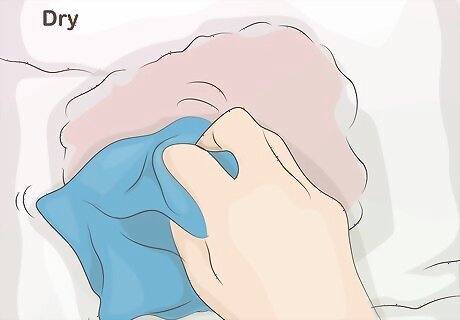
Rub the area with a dry cloth. With the right spray in place, the chemicals can do their work. It's up to you to make sure they get around. Rubbing a dry cloth up against the affected area will give the paint somewhere to soak up into. Continue rubbing the area, and don't be afraid to get rough with your rubbing. If one area of your cloth gets too saturated, move onto the next. It is obviously preferable that the dry cloth in question isn't one that you would care much if it got discoloured. Repeat the process until you've removed as much paint as you're reasonably going to. Don't be surprised if you're not able to get all of it out. Every smidgen of paint soaked out makes the existing stain less apparent.
Cleaning Dried Stains
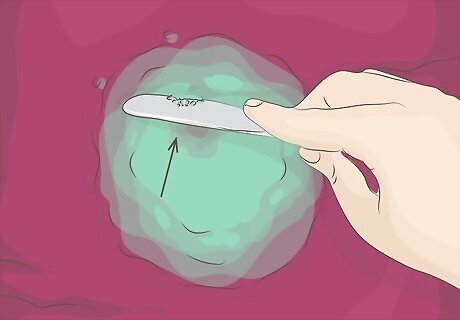
Scrape off excess paint. Paint that has dried onto clothing is a real pain to get off, and you might have to resign yourself to the fact that it will never be removed completely. All the same, you can get a surprising amount of it removed without any chemicals or fluid. Taking a butter knife or your fingernail, scrape the excess paint away from the stain. Because the paint has dried, it will actually come off in chunks. You won't be able to scrape the paint that has soaked into the fabric, but the simple act of scraping the stain may have a significant impact on removing it.
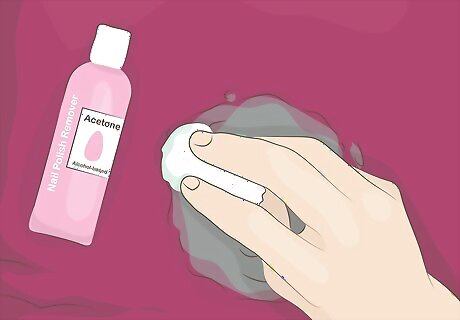
Use an alcohol-based cleaner or paint remover. Alcohol-based cleaners, like acetone nail polish remover or hairspray, are arguably your best bet for fighting acrylic-based spray paint stains. These cleaners will break the bonds in the acrylic plastic. Unfortunately, they're far less effective once the paint itself has set into the clothes. If the stain is completely dried and you haven't seen any improvement from the alcohol-based cleaners, a heavy-duty paint remover may do the trick. Keep in mind, however, that paint removers have some tough chemicals in them, and they might strip the dye from your shirt completely. As such, they should only be used as a last resort.
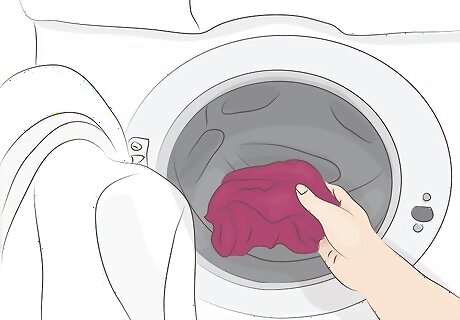
Throw it in the laundry. Laundering clothes after treating a stain with an alcohol-based cleaner will at least offer some confirmation whether the stain is removable or not. If it comes out of the laundry with the stain in place, there's nothing you can do outside of covering it up. Luckily, certain stains (especially on black clothing) can be covered quite well with fabric pens and other "destaining" products.
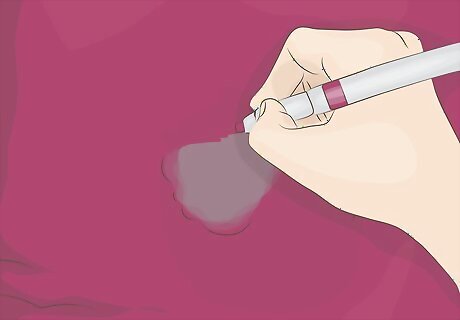
Use a fabric-coloured pen to hide the stain. Because dried paint is essentially bound to the fabric it has stained, sometimes the best option is to fight one stain with another. There are fabric pens available that are specifically intended for covering up paint stains. Go to a arts or fabric store and try to find a pen that matches the colour of your clothes. Paint shows up on jeans like a sore thumb, but you may be in luck if denim is your problem. Because denim tends to be in shades of blue and black, there are lots of paint pens that fit this range.
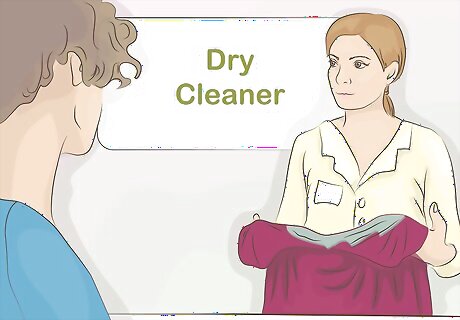
Talk to your dry cleaner. Laundering clothes actually tends to solidify any dried stains on your clothes. Given that dry cleaners are professionals (and have no doubt handled an issue like this before) you may find it helpful to bring the issue to their attention. Even if they're not able to fix it via cleaning, they still may be able to offer advice or help that is specifically catered to the type of stain at hand.
Preventing Stains Outright
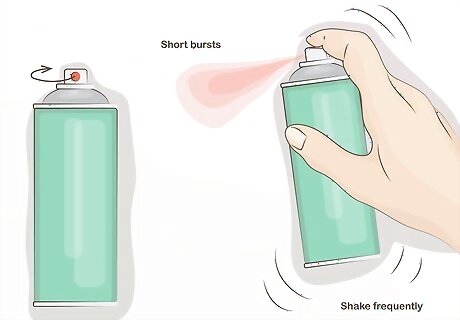
Regulate your spraying. While other kinds of paint stains can result from dripping or excess paint, a spray can is specifically made to be accurate and precise. With this in mind, your first step towards preventing paint stains should be the proper use of the spray paint itself. Spray the can in short, controlled bursts. Make absolutely sure the nozzle is turned away from you before you fire. Remember to shake the can frequently to improve the paint's consistency. Check the instructions on the can if you have any doubts.
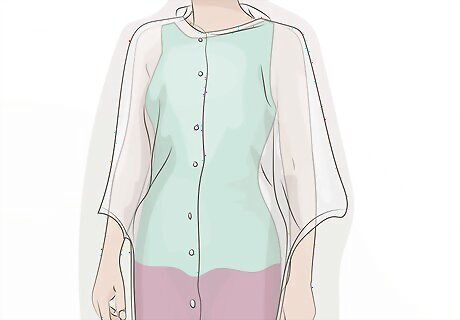
Wear a paint poncho. Paint ponchos are specially designed to protect your clothing from staining. They can be bought relatively cheaply at a local hardware store. Failing that, you can also make a paint poncho of your own by cutting arm holes in a garbage bag and wearing it while you work. Paint ponchos can be uncomfortable, especially if you're painting somewhere where it's already hot. Still, the mild discomfort is more than worth saving your clothes from harm.
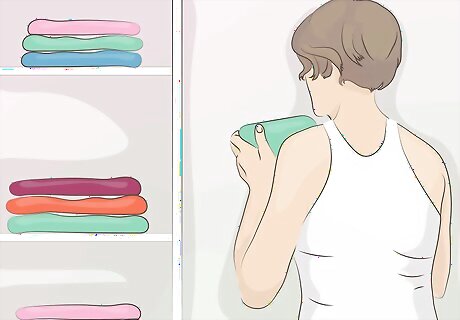
Strip to your underwear while painting. Obviously, getting down to underwear while you paint is reserved only for a few scenarios. Painting at home and inside make the most sense in this case. However, you can't risk messing up your clothes if you're not wearing them. Due to the fact that drying paint absorbs heat, disrobing also helps tend to the issue of overheating while painting.
















Comments
0 comment